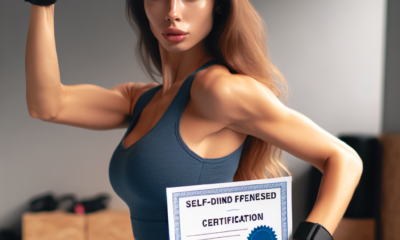Womens Self Defense
Learn How to Protect Yourself with Self-Defense Certification
In today’s world, personal safety is a significant concern for many individuals. Whether walking home late at night, traveling to unfamiliar places, or simply navigating day-to-day life, having the knowledge and skills for self-defense is becoming increasingly essential. One way to equip yourself with these vital skills is through self-defense certification programs.
Understanding Self-Defense Certification
Self-defense certification programs are designed to teach individuals practical techniques and strategies for effectively protecting themselves in dangerous situations. While there are various styles and methodologies—ranging from martial arts-based systems to simple situational awareness—the common goal is to empower participants with the confidence and skills to defend themselves.
Types of Self-Defense Programs
-
Martial Arts Classes: Many self-defense certifications stem from traditional martial arts disciplines like Brazilian Jiu-Jitsu, Krav Maga, Taekwondo, and Muay Thai. These classes often cover not only physical techniques but also mental preparedness and situational awareness.
-
Specialized Self-Defense Courses: Some organizations offer courses specifically tailored for self-defense, focusing on practical scenarios and common threats, often in a short, intensive format. These may include workshops on escaping holds, defending against armed attackers, or responding to threats.
- Online Courses: With the rise of online learning, numerous self-defense programs are available virtually. These courses allow individuals to learn techniques at their own pace and in the comfort of their homes while providing instructional videos and supporting resources.
Why Get Certified?
-
Confidence Building: Truly knowing how to protect yourself enhances your confidence. The skills learned in self-defense certification can help you feel more secure in various environments, reducing anxiety related to potential threats.
-
Personal Safety: Equipped with efficient self-defense techniques, you have practical tools at your disposal, making it easier to respond effectively in unpredictable situations.
-
Physical Fitness: Many self-defense classes also incorporate physical conditioning, improving your overall health and fitness. This dual benefit can enhance your energy levels and well-being.
-
Community Connections: Joining a self-defense program often leads to meeting like-minded individuals. This sense of community can provide additional support in your journey to personal safety and empowerment.
- Critical Life Skills: Beyond physical techniques, self-defense training teaches important life skills such as awareness, assertiveness, and decision-making under pressure—skills that are applicable in various aspects of life.
Choosing the Right Certification Program
When selecting a self-defense certification program, consider the following factors:
-
Instructor Credentials: Look for instructors with solid backgrounds in self-defense training and teaching experience.
-
Program Structure: Determine if the course meets your needs—some may focus on practical defense skills, while others might offer a broader overview of personal safety strategies.
-
Location and Accessibility: Ensure that the program is conveniently located or offers online options that fit your schedule.
- Course Reviews: Research testimonials or reviews from former participants to get a sense of the program’s effectiveness and overall experience.
Conclusion
Investing time in a self-defense certification course can be one of the most empowering choices you make. It not only equips you with the tools to protect yourself but also fosters confidence, physical fitness, and a sense of community. As you embark on this journey to personal safety, remember that the ultimate goal is to empower yourself—your safety is in your hands. By learning self-defense, you will walk through the world with a greater sense of security and assurance, ready to face any challenges that come your way.
Womens Self Defense
Female version 👌🤯 of Bruce Lee is indeed worthy of her reputation #kungfu

Female version of Bruce Lee is indeed worthy of her reputation #kungfu #martialarts #mma #karate #kickboxing #boxing …
source
Womens Self Defense
How Public Defense Measures Ensure Equal Justice for All

In any democratic society, the principle of equal justice under the law is a cornerstone that upholds the rights of individuals, regardless of their background or socioeconomic status. Public defense measures play a critical role in embodying this principle, ensuring that everyone—including those who cannot afford private legal counsel—has access to competent legal representation. This article explores the importance of public defense, the challenges it faces, and how it ultimately contributes to a more equitable legal system.
The Essential Role of Public Defenders
Public defenders serve as the legal backbone for those accused of crimes who lack the financial means to hire private attorneys. Their role is essential in safeguarding the rights of defendants, particularly in a system where the stakes are incredibly high—liberty, reputation, and futures hang in the balance. Public defenders provide legal representation in criminal cases, ensuring that each defendant receives a fair trial, a right guaranteed by the Sixth Amendment of the U.S. Constitution.
Promoting Fairness in the Legal System
-
Access to Justice: Public defense measures enable low-income individuals to navigate the complexities of the legal system. Without access to a lawyer, many defendants would struggle to understand the charges against them or the implications of their plea choices.
-
Quality Representation: Public defenders are trained legal professionals. They possess the knowledge and skills necessary to mount a defense, negotiate plea deals, and advocate for their clients’ best interests. Their expertise helps level the playing field in courtrooms often dominated by well-funded prosecutors.
- Impartiality: A public defender’s objective is to represent the client’s best interests without bias. This helps mitigate potential inequalities that might arise when individuals are pitted against the state, which often brings substantial resources to bear in its pursuit of convictions.
Challenges Faced by Public Defense Systems
Despite the vital role public defenders play, they often encounter significant challenges that can undermine their effectiveness:
-
Underfunding: Many public defense systems are severely underfunded, leading to high caseloads that jeopardize the quality of representation. A public defender might be assigned multiple cases at once, limiting the time and resources they can dedicate to each defendant.
-
Resource Constraints: Public defenders frequently lack the resources typically available to private attorneys, such as access to expert witnesses, investigators, and adequate support staff. This disparity can hinder their ability to build strong defenses.
- Systemic Issues: The adversarial nature of the justice system, combined with societal prejudices and systemic inequities, can further complicate the public defense landscape. Disparities in treatment based on race, gender, and socioeconomic status can influence outcomes, further necessitating strong public defense measures.
Advocacy for Reform
Recognizing the challenges faced by public defenders, various organizations and advocacy groups are pushing for reforms. These include:
-
Increased Funding: Advocates argue for enhanced funding for public defense services to ensure that defenders can manage reasonable caseloads and provide quality representation.
-
Policy Changes: Legislative measures aimed at strengthening public defense include creating standards for attorney-client ratios and mandating training for public defenders in areas such as mental health and trauma-informed legal representation.
- Public Awareness Campaigns: Educating the public about the importance of public defense can help garner support for reforms. When citizens understand that public defenders are essential for a fair judicial process, they may be more inclined to advocate for systemic changes.
The Path Forward: Ensuring Equal Justice for All
Public defense measures are not merely a legal obligation; they are a moral imperative. By ensuring that all individuals have access to legal representation, we enhance the integrity of the justice system as a whole. A well-functioning public defense system not only protects the rights of the accused but also holds the state accountable, fostering trust in the legal system.
In conclusion, the role of public defenders is fundamental to maintaining equal justice for all. As society continues to grapple with issues of inequality and access to justice, it is imperative that we support and invest in public defense measures—ultimately ensuring that the scales of justice tip towards fairness, irrespective of an individual’s economic circumstances. With adequate support and reform, public defense can truly embody the American ideal of justice for all.
Womens Self Defense
Women’s Guide to Safe Solo Travel

Absolutely! I’m Jade Tripp, and today, we’re diving into an empowering topic: "Empower Yourself: Essential Self-Defense Techniques Every Woman Should Know". Let’s get started!
Empower Yourself: Essential Self-Defense Techniques Every Woman Should Know
Hello, ladies! Today, we’re opening a crucial conversation about self-defense. Women everywhere should feel powerful, confident, and safe in their everyday lives. It’s not just about physical abilities; it’s about mindset and preparation. Let’s break down some practical self-defense techniques that every woman can learn and utilize.
1. Situational Awareness: Your First Line of Defense
Before we get into specific techniques, let’s discuss the cornerstone of self-defense: situational awareness. This means being aware of your surroundings and understanding what is happening around you.
- Tip: When walking alone, keep your head up, avoid distractions like your phone, and scan your environment. Practice being present—notice exits, potential hazards, and the people around you.
For example, Sarah, a 28-year-old who recently took a self-defense class, learned how to identify potential threats while walking to her car at night. By being more conscious of her surroundings, she found she was less anxious and better prepared.
2. Verbal De-escalation: The Power of Words
Often, the best self-defense technique is to talk your way out of a situation. Learning how to confidently assert yourself can defuse a potential confrontation.
- Techniques:
- Use a firm, confident tone.
- Clearly express that you want the person to leave you alone.
- Recognize behavioral cues that might signal aggression.
Emily, a self-defense instructor in San Diego, shared a powerful example: she once faced an aggressive individual while jogging. Instead of escalating the situation, she firmly stated, “I don’t want any trouble. Please walk away.” The assertiveness halted the confrontation.
3. Basic Physical Techniques: Strikes and Escapes
Though we hope never to use them, it’s crucial to know some basic physical self-defense techniques.
- Target Vulnerable Areas:
- Eyes: A quick poke can create an opportunity to escape.
- Nose: A solid strike can disorient an attacker and give you time to flee.
- Throat: A swift jab can incapacitate briefly.
Example: In a self-defense workshop held in New York City, women practiced these techniques on padded dummies. Many participants reported feeling empowered and less fearful after learning how to use their instincts and strength to defend themselves.
4. Using Everyday Items as Weapons
You don’t need a personal weapon to defend yourself; everyday items can be effective tools.
- Items to Consider:
- Keys: Hold them between your fingers to create a makeshift weapon.
- Pen: A sturdy pen can be used to jab in an emergency.
- Bag: Swing it or hit your attacker with it.
Remember Annie, who works at a café in Chicago? One day, she was approached in a parking lot; she grabbed her bag and swung it toward her attacker, which startled him long enough for her to escape.
5. Self-Defense Classes: A Supportive Community Experience
Getting involved in self-defense classes can be empowering and fun! It’s a great way to meet other women, share experiences, and learn in a supportive environment.
- Recommended Classes:
- Krav Maga: An Israeli self-defense system focusing on real-world situations.
- Women’s self-defense classes: Many community centers and gyms offer female-focused training.
In Denver, a group of women decided to join a local krav maga class. Not only did they learn practical skills, but they also formed friendships that turned into a support system, helping them build confidence both inside and outside the dojo.
6. Building Confidence Through Practice
Finally, like any skill, self-defense techniques require practice. Regularly revisiting what you’ve learned helps reinforce your skills and builds muscle memory.
- Tip: Pair up with a friend or join classes together. Practice not just the physical techniques, but also the assertive language that accompanies them.
Candace, who took a self-defense workshop with her best friend, shared that practicing together made her feel stronger and more capable. They even found themselves more aware in their daily lives, each encouraging the other to stay alert and empowered.
In Conclusion
Empowering yourself with knowledge and skills is the first step toward feeling safe. Remember, it’s about both physical techniques and mental preparedness. Everyone has the right to feel secure and confident, and you can equip yourself with the tools you need to navigate your world safely.
So, ladies, let’s embrace our strength and take charge of our safety together. Whether it’s joining a class, reading articles, or simply being aware of our surroundings, every step you take counts. You’ve got this!
Stay strong and confident,
Jade Tripp
If you have any questions or want to share your experiences, feel free to reach out!
-

 Womens Self Defense10 months ago
Womens Self Defense10 months agoNew Legislation Empowers Women to Defend Themselves
-

 Self Defense News1 year ago
Self Defense News1 year agoShe was convicted of killing her abusive boyfriend. Now a Maple Grove woman is home awaiting a new trial.
-

 Self Defense News1 year ago
Self Defense News1 year agoSelf-Defense for All: The new Gracie Jiu-Jitsu Pasadena is for everyone | Online Features
-

 Womens Self Defense1 year ago
Womens Self Defense1 year agoTop 5 Self-Defense Techniques Every Woman Should Know
-

 Womens Fitness1 year ago
Womens Fitness1 year agoXtreme Bodyweight HIIT (Lots of Jumping!) | Joanna Soh (Fio Series)
-

 Womens Self Defense7 months ago
Womens Self Defense7 months agoUnderstanding State-by-State Variation in Self Defense Laws
-

 Womens Preparedness1 year ago
Womens Preparedness1 year agoThe Importance of Self-Sufficiency Skills in Today’s World
-

 Womens Preparedness1 year ago
Womens Preparedness1 year ago10 essential skills for surviving in the great outdoors





